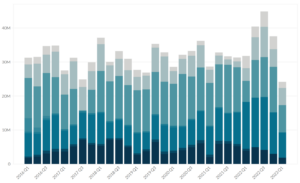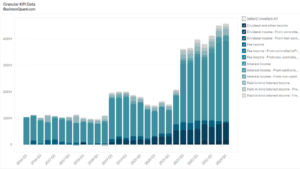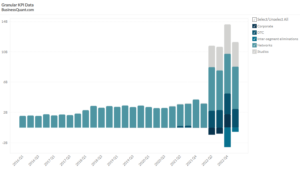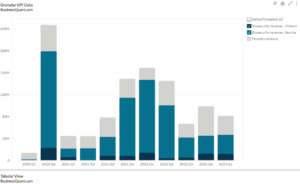
American Airline’s Average Seat Miles (2016-2023)
Exclusive Data
You need the Pro Plan to access KPI data
- Full access to the platform
- KPI data & segment financials on US stocks
- Financial data on thousands of stocks
- Download data in xlsx and csv formats
Pro Plan
$49 per month*
60% discount ends in:
.
About
More information
Subscribe to Pro or Enterprise plans to unlock this feature.
Contact the Analyst
Subscribe to Pro or Enterprise plans to unlock this feature.
Become a smarter investor today.
Access KPIs & Segment Financials on US stocks
This statistic highlights American Airline’s Average Seat Miles, reported on a quarterly basis from Q1 2016 onwards.
American Airlines is the principal subsidiary of AMR Corporation. The company’s passenger division is one of the largest scheduled passenger airlines in the world. Their cargo division is one of the largest scheduled air freight carriers in the world. American operates American Eagle, a group of four small regional airlines that connect passengers from smaller markets into American’s hub system. They operate their primary and largest Maintenance and Repair Operations (MRO) base in Tulsa. American Airlines and American Eagle operate out of 10 hubs with Dallas being the largest. The airline’s segment operates in two divisions – mainline and regional, with the former being the major segment. The company’s passenger segment accounts for more than 90% of the company’s total revenue. The cargo segment accounts for 2% and the other e=services form the remaining. The company has around 1500 aircraft in its fleet. 900 aircraft are used for mainline services and 600 for regional services.
American Airline’s Average Seat Miles
Available seat miles refer to how many seat miles are actually available for purchase on an airline. ASM is a measure of an airplane carrying capacity available to generate revenue.
The ASM for American Airlines has been as follows:
In the first quarter of 2016, the average seat miles had increased to 65.06 billion, 70.75 billion in the second quarter, 71.91 billion in the third quarter, and 65.68 billion in the last quarter.
In the first quarter of 2017, the ASM reduced to 64.34 billion and then increased to 71.74 billion in the second quarter, 73.05 billion in the third quarter, and 67.36 billion in the fourth quarter.
In 2018 the ASM increased to 65.82 billion in the first quarter, 72.89 billion in the second quarter, 75.04 billion in the third quarter, and 68.30 billion by the end of the year.
The ASM increased further in 2019 to 66.67 billion in the first quarter, 72.32 billion in the second quarter, 75.82 billion in the third quarter, and 70.27 billion by the fourth quarter.
The average seat miles have been increasing every year. An increase in average seat miles might potentially increase earnings as the company can accommodate more passengers in their airplanes. The average seat miles have increased from 68.35 billion in 2016 to 69.12 billion in 2017 to 70.51 billion in 2018 and 71.27 billion in 2019. This increase in average seat miles indicates that the company has more room to increase their revenues.
In 2020 though the average seat miles might remain the same the company will not generate revenue on account of the ban on travel due to the current pandemic situation. Almost all airline companies in almost every part of the world are facing a tough situation. Airlines with poor financial stability are facing a solvency crisis. Thanks to American Airline’s strong performance over the year, the airlines is far from facing such a situation.
Did you like American Airline’s Average Seat Miles statistic?
Access more such KPI data points and segment financials on thousands of US stocks, with Business Quant.
You can get started here.
More data on US Stocks

Our Plans
Always know what you’ll pay. No hidden costs or surprises.
- Annual
- Monthly
60% discount till April 30
Pro
For serious investing
-
Company KPI data Access segment financials, non-GAAP metrics and KPI data from presentations and filings. Examples include financials by segment / region / product category, AT&T's broadband subscriber trends, Tesla's deliveries by model and lots more.
-
Stock research tools Features include : stock screener, stock comparison, industry financials, stock warnings, advanced charting tools, timeseries tables, scatter charts, financial statements, stock reports, SEC filings, stock ratings, institutional and insider ownership data. There are 200+ financial items and ratios on thousands of US stocks.
-
Industry data & tools Access premium operating data on 40+ industries. Examples include market share, smartphone shipments by vendor, subscribers by wireless carrier, historical gold production. There are 20,000+ such statistics.
Enterprise
For tailored workflows
-
All of Pro plan Get unfettered access to all our dashboards and dossiers.
-
Custom built features Get tailored dashboards built specially for you , based on your set of requirements, to simplify your research workflow.
-
Admin billing Back-end documentation support and multi-seat licensing.
* Billed annually, local taxes extra.
60% discount on Annual plan
Pro
For serious investing
-
Company KPI data Access segment financials, non-GAAP metrics and KPI data from presentations and filings. Examples include financials by segment / region / product category, AT&T's broadband subscriber trends, Tesla's deliveries by model and lots more.
-
Stock research tools Features include : stock screener, stock comparison, industry financials, stock warnings, advanced charting tools, timeseries tables, scatter charts, financial statements, stock reports, SEC filings, stock ratings, institutional and insider ownership data. There are 200+ financial items and ratios on thousands of US stocks.
-
Industry data & tools Access premium operating data on 40+ industries. Examples include market share, smartphone shipments by vendor, subscribers by wireless carrier, historical gold production. There are 20,000+ such statistics.
Enterprise
For tailored workflows
-
All of Pro plan Get unfettered access to all our features.
-
Custom built features Get tailored dashboards built specially for you , based on your set of requirements, to simplify your research workflow.
-
Admin billing Back-end documentation support and multi-seat licensing.
* Local taxes extra.






